
Living on the Edge of Vision:
a blueprint for thriving on Earth :
June 8, 2016
Near Term (25 years) 1. Direct Air Capture and Sequestration of CO2.
Mid term (50 years) 2. Mitigating the Drought in the US Southwest
Long Term (150 years) 3. Significantly Influencing the Earth’s Hydrologic cycle through increasing water vapor, cloud formation, and terrestrial precipitation
Introduction:
The proximate source of the problem.
Mankind is endowed with an intellect which allows recall of the recent past; an assessment of current assets; and the planning of steps to be taken to attain a visualized and desired outcome.
Along with this profoundly powerful utilitarian capacity, there has arisen in the human psyche the ego, or “I thought”, which has sustained the illusion of separation from the environment.
The “successes” of human enterprise,-( as directed by aspirations of the individual, clan, tribe, state, and nations.)- constitute, in the aggregate, an existential threat to the continuation of civilization, and perhaps Life itself, on this planet. The Earth, once seen as boundless in its resources, is now losing its vitality at a rate unseen in the geological record, as measured by the rate of species extinction.
Presuming that humankind will address the many institutionalized aspects of society which must be changed in order to thrive, there remains the inexorable facts of rapid climate change, whose increasingly deleterious effects are only just beginning to be felt.
World leaders and policy makers generally appear to be cognizant of the looming catastrophic consequences of “Global Atmospheric Warming” (and related consequences arising from excess CO2), and are endeavoring to install procedures which will reduce the rate at which we are rushing towards a poorly defined “tipping point”, at which time self reinforcing feedback mechanisms will cause massive global species extinction.
The increasing circulating atmospheric CO2 arising from human activities, (principally the burning of carbonaceous fuels), is the main factor in the rising temperature gradient. In the mid 1800's, the atmospheric concentration of CO2 was ~ 275 PPM: the current concentration is slightly above 400 PPM, and the rate of increase continues to rise.
Given the momentum of human activities, it is of critical importance that a methodology be developed and employed to capture excess CO2 directly from the ambient circulating air.
The following describes a way to effect this desired outcome, while also producing desirable ancillary benefits.
The document is organized as follows:
Introduction (Above)
Proposal
Geology
Chemistry
Physical Plant Description
Ancillary Benefits
Downwind Precipitation
Current “next steps” and “needs analysis”
Future Actions
Cycling CO2 from ocean water, to form terrestrial mineral carbonates
Increasing cloud cover and rainfall, over continental land masses
Offsetting O2 deprived seasonal “dead areas” in localized ocean areas
Apologetics, and Conclusion
Notes and references
Attachments:
[1.] Pat.pend. Docket 11149
“Carbon Dioxide Direct Air Capture and Sequestration Utilizing Endorheic Basin Alkaline Deposits to Effect Mineral Carbonation”
(David O. Newell)
[2.] “Spray Turbines to increase Rain by Enhanced Evaporation from the Sea”
10th Congress of International Maritime Association of the Mediterranean, Crete, May 2002
(Stephen Salter, Division of Engineering, University of Edinburgh, Scotland)
[3.] Calculation of CO2 flow through plane of water spray fan per nozzle per year
[4.] Basis for “ Request for Quote” (RFQ) from 3rd Party Investigators
Picture and graphics locations credits, and permissions schedule, delineated in body by { } brackets
References, by number citation in body, delineated by ( ) brackets
further note:
Some “poetic license” was taken in the geology portion, to simplify and consolidate some of the divergent historical scenarios promulgated by those which were sourced: no salient matters were omitted or distorted.

Proposal:
GEOLOGY:
{1}
Several million years ago, the subduction of the Farallon Plate under the North American Plate caused a ~450 mile long piece of the North American Plate to break off and rotate along its long north-south axis, which formed the Sierra Nevada mountain range; and also produced the "Great Basin", which is a portion of the “Basin and Range Province” which includes much of the Western United States.

{2}
The scope of the former Lake Lahonton
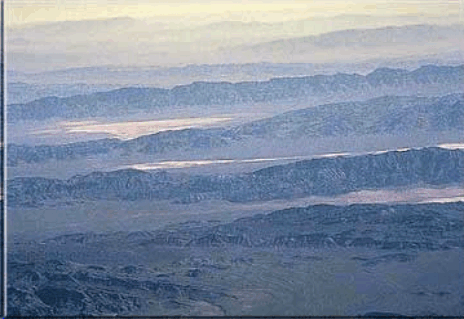
{3}
A view of a typical portion of the “Great Basin” showing the “basins” and “ranges”
The “Great Basin” is cut off from any water leaving from it’s confines, except by evaporation.
The "basement rock" of granitic nature which was exposed by the formation of the Sierra Nevada, was subject to rapid weathering from water, ice, and wind during the 2.5 million year Pleistocene Era, which ended approximately 12,000 years ago.
The weathering products of granite consist primarily of the light and reactive metals of magnesium, aluminum, calcium, sodium, and potassium.
These ultimately very finely graded clay-like materials eventually wound up distributed across the Great Basin by water, predominantly in the former Lake Lahonton, which covered much of Northern Nevada.
The evaporation of Lake Lahonton, for the most part completed by approximately 9,000 years ago, left huge "alkaline dry lake playas", the most well known of which is probably "Black Rock Desert", which hosts the "Burning Man" event every labor day .
There are several trillion tonnes of reactive alkaline material contained in these playas, across Nevada. .
According the BLM in Winnemucca, there is no reason to think that the material located at deeper levels in the playas, (which in many cases are over 8,000 feet deep) is any different than the material on the surface. (There is some supposition that the materials are more basic than at the surface, but this remains to be proven.)
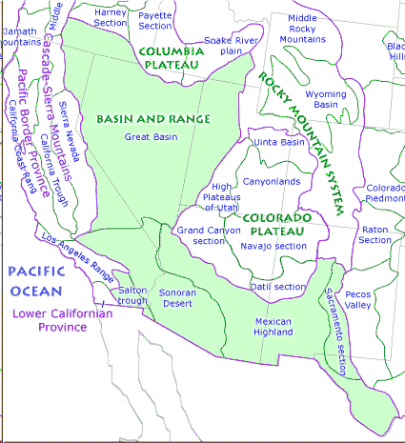
{4}
The “Great Basin” seen as a portion of the “Basin and Range Province”
The Western edge of the “Great Basin” in the vicinity of the “Black Rock Desert Playa” has an average annualized wind speed of 10 MPH from NW to SE, blowing at approximately right angles to the north/south orientation of the many high ranges (over 7,000 feet elevation) found within it’s confines. (See upper picture, page 5)
Because of the “rain shadow” caused by the Sierra Nevada to the West, the Great Basin gets little rainfall: around 5 inches in the sample area.
Because of the stretching of the Earth’s mantle which gave rise to the “basin and range” topography, the crust is thinner, and therefore hotter, than in most other parts of Earth, due to heating from the Earth’s core.
These facts combine to give the area an evaporation rate of approximately 50 inches of water per year, and support the contention that almost all water that is imported into the basin will evaporate in short order, unless design considerations are employed to preclude that occurrence.
CHEMISTRY
The chemistry of CO2 dissolved in water is more complex than expected. However, the critical essence of the matter is found in the following graph
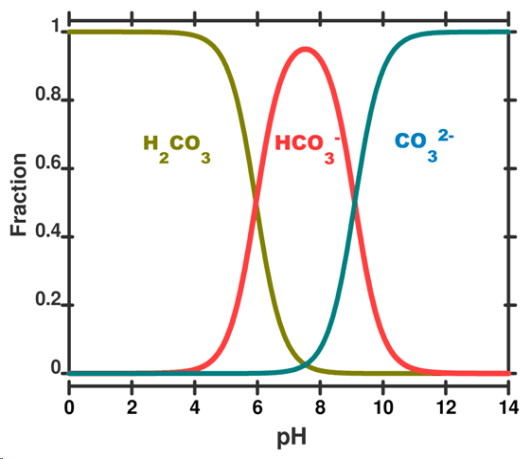
As can be noted, carbonic acid, (H2CO3) is likely to form at the lower pH ranges (left side of chart..) , and is the “culprit” in ocean acidification. At middle pH’s (pH 7 is considered “neutral”), CO2 forms a bicarbonate modality, (HCO3 ^-1) and will not out gas from water. ,. At pH 8.5 to pH 9, the Carbonate moiety (CO3^-2) begins to dominate,.
What is important to register is that the reversible and acidic Carbonic Acid cannot form (in significant amounts) at pH ~8.2 or higher (pH ~8.5 or so, for ocean water with 3% NaCl), and if metal ions are available, precipitates of bicarbonate or carbonates can be expected. Tufa columns demonstrate a natural manifestation of the chemistry.
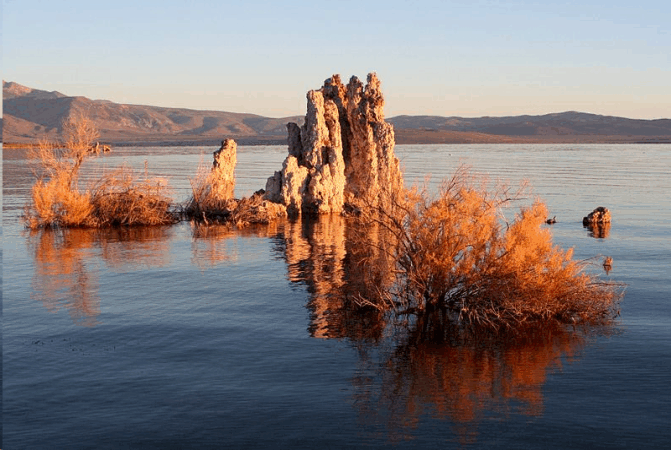
{6}
Tufa towers like these in Mono Lake are calcium carbonate spires and knobs formed by interaction of freshwater springs and alkaline lake water
I have checked the pH of water over these soils, (see attachment [1] ) and have found the minimum pH to be approximately 8.5, and the maximum to be approximately 9.8.
PHYSICAL PLANT PROPOSAL
Scale of the proposal, by comparison to an existing pumping structure
Nearly 5% of the electricity used in California, year to year, is employed to power the Edmonston Pumping Station, which lifts fresh water across the Tehachapie Mt. Range, dividing Northern California. from Southern California
Edmonston Pumping Station profile:
Normal static head: 1,970 ft
Total flow at design head: 315 ft³/s (9 m³/s) (per unit)
Motor rating: 80,000 hp (60MW)
Flow at design head: 315 ft³/s (9 m³/s) (per uniit)
Total flow at design head: 4410 ft³/s (450,000 m³/h) (Combined)
Total Motor rating: 1,120,000 hp (835 MW)[2]
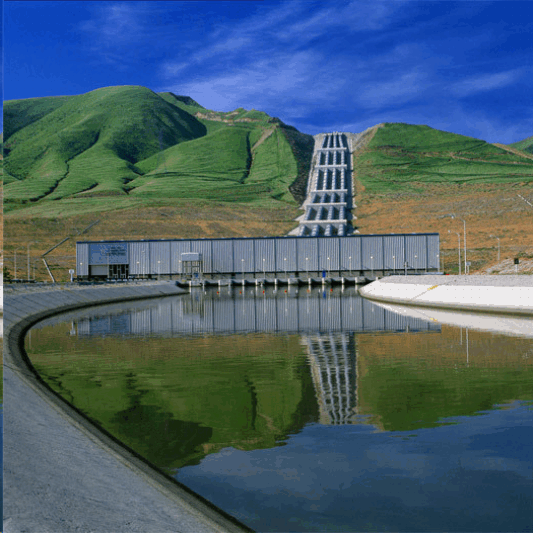
{7}
California Aqueduct at the Chrisman Pumping Plant, 13 miles before reaching the Edmonston Plant.
Hypothesizing broadly, a 3/4 to 1 gigawatt power plant could lift 1/3 the water, or ~1470 cu. feet of water second (150,000cu.M/ Hr.) 3 times as high, or ~ 6,000 feet.
This would enable a 2,000 foot "head" of pressure to effect delivery of the ocean water to wherever you may run the delivery pipes in Nevada, whose playas are at approximately 4,000 feet above sea level.
This comparison is made so that the project can be seen as imminently “doable” if the will to do so is established.
The envisioned structure would consist of pumps to convey Pacific Ocean water from (probably) the vicinity of Eureka, to lined retention basins located on the Eastern slope of the Sierra Nevada; and thence released and conveyed by piping as circumstances dictate through spray nozzles arranged on the upwind side of the playas to be so utilized. (Sketches are found in attachment [1] )
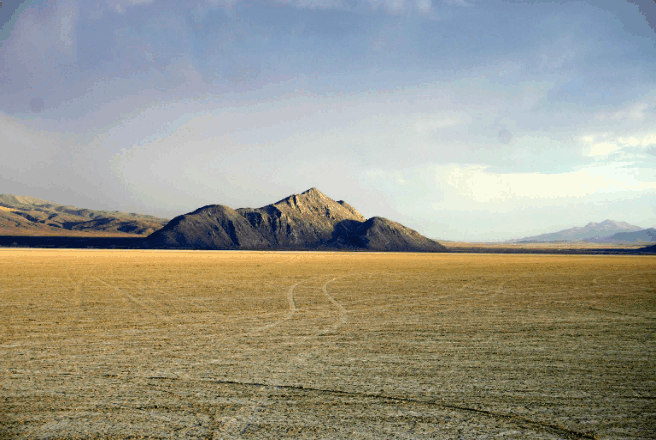
{8}
Black Rock Desert Playa
In my sample, I used the Black Rock Desert Playa as the “example.”: it is both relatively close, and better characterized than any of the many other playas which could be employed. Also, it is a “saline” playa, and thus not changed in this protocol, which envisages the use of saline ocean water.
The spraying of ocean water through adjustable nozzles in fans of approximately 150 foot radius will generate “customizable “ droplet sizes to effect varying degrees of CO2 absorption and water evaporation, as is required by operational circumstances .
Presuming, then, a 150 foot radius spray fan, and an average wind speed of 10 MPH, the volume of CO2 which will pass through the plane of the fan half-circle, per year, is ~ 200,000 metric tonnes. This is for one “spray rig”. Ultimately, thousands are envisaged. (See attachment [3] for single sprayer CO2 “flow” per year.) )
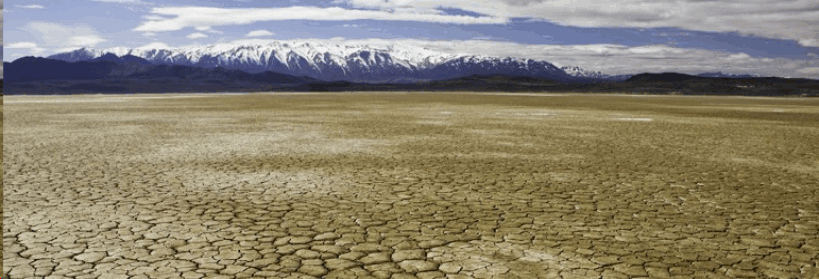
{9}
The Black Rock Playa in northwestern Nevada is one of the largest, flattest, surfaces on Earth, covering approximately 200 square miles. (Looking West, towards the Sierra Nevada)
It would be desirable to isolate portions of the Playa downwind of the sprayers to retain the water in shallow local ponds. The pH of the impounded waters would be monitored, and deeper levels of the playa soils would be accessed by the use of water jets to”drill down” through the consolidated clays, when necessary. As precipitated carbonates and salts build up in the impoundment, the location of the spray nozzle may be moved to a new area.
It remains the results of field tests to determine which method of spraying water will be the most satisfactory: (see attachment [4] )
—The direct spraying of ocean water above the playa surface
—The vacuum induction of supernatant playa water into the nozzle stream, similar to an “aspirator” mechanism
or
— The regeneration of electricity at the spray head location so that supernatant playa water can be pumped through the nozzles.
In addition, imparting an electrostatic charge to the droplets through electrification of the spray nozzles may be contemplated, to both keep the droplets discrete from one another, and/or modify the residence time of the flight path of the droplets, as described in attachment [2] )
Obviously, the first two methodologies are less expensive, but the increased efficiency of higher pH and “cation loaded” droplets of water being sprayed may make it worth while to use the modified techniques.
Volume of reactive materials.
Pictures {8} and {9} give a general idea of the vastness of these repositories of alkaline clay soils.
The deposits are several thousand feet deep. Although there are likely to be large pieces of fault-scarp block material towards the bottom, the great majority of the depth of material is finely ground deposits transported from weathered rocks, as described under the “Geology” section above.
Utilizing the sequestration of pure CO2 results shown in attachment [1] for Black Rock Playa mud from two locations, it is easy to project an ultimate sequestration potential at this playa of several billion tonnes: but the sample size used in the exhibit, measured in CC’s, when extrapolated to a putative block of playa soil 20 miles square and 1,000 feet deep...., can only be regarded as “prone to error”. (See “Current “next steps” and “needs analysis”“ below.)
ANCILLARY BENEFITS
The importation and spraying of ocean water over the playas will result in evaporation of most of it, to be controlled by the size of droplets eluted from the spray nozzles, and the size of the retention ponds formed by soil berms downwind from the nozzle spray heads.
Evaporation of the water will form parcels of (relatively) unstable cool and moist air flowing downwind, in summer, displacing the warmer air in a manner similar to a “cold front”. Orographic lifting” of the parcels of moist, dense air can be expected as a result of the topography. (Described above under “geology”)
Adiabatic expansion will occur, and clouds may be expected to form. An approximately 10 degrees F. Temperature drop in the moving air parcel could be expected, rising over a 7000 foot elevation.
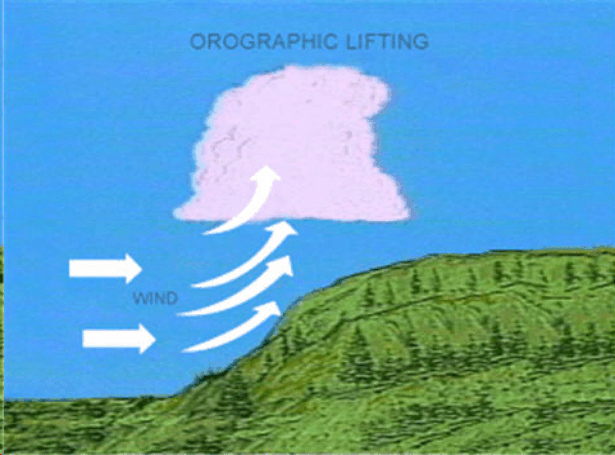
{10}
Orographic lifting occurs in mountainous terrain when a mass of moving air is forced to rise because of the presence of slope. Air that is forced upward cools adiabatically. If this air reaches its saturation point, clouds develop. Orographic lifting and thermal lifting often work together to produce cumulus clouds in mountainous areas.
Presume that all of the imported water (150,000 Cubic Meter/ Hour.: mass, 1030 KG/ Cubic Meter) Is sprayed over a 30 mile line of sprayheads on the upwind side of the playa. The mass per hour =~ 1.545 X 10^8 kg.
The water density of a cumulus cloud is ~ ½ gram / cubic meter.
Generalizing a decent cumulus cloud size to be 1 KM on each edge, the mass of a cloud’s water is about 500,000 KG, or an evaporation generating “309 clouds per hour.” About 5 per minute.
Note that the conditions which exist during summer weather will likely form “streaming cirrus” cloud forms rather than cumulus, though the water content will be equivalent.
See “How Much Does a Cloud Weigh?”
http://mentalfloss.com/article/49786/how-much-does-cloud-weigh
(This reference is included here, as there is much speculation on the internet which varies widely)
Speculation aside, the evaporated water will increase the cloud cover downwind, and result in increased precipitation. The precipitation may occur inside the “Great Basin”, or may occur downwind of it.
The nearest downwind area south and east of the Great Basin, is the Colorado River Drainage.
Should a plurality of the many Playas in Nevada be provided with physical plant devices such as that proposed (as example) in the Black Rock Desert Playa, with water imported and sprayed in similar fashion, then the amount of clouds and downwind precipitation to be expected could be large enough to address the increasing drought in both the Colorado River and the Rio Grande drainage areas.
A (more) plausible scenario eventuates when contemplating the effect of spraying this relatively warm ocean water in cold winter breezy conditions.
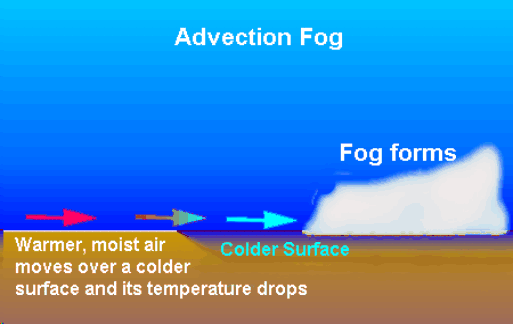
{11}
Advection fog and snow will likely occur closely downwind of the spray zone area. Known as “The Lake Effect”, the conditions of a warm, moist quantity of air being distributed into a colder mass of air is quite similar to the circumstances which give rise to the so-named phenomenon. The previously referenced orographic lifting should produce thicker clouds and snow on the nearby downwind mountains..
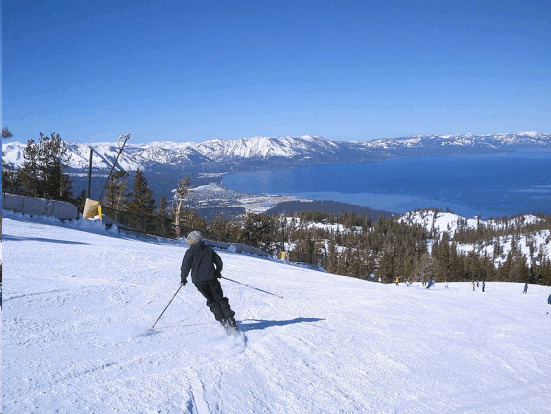
{12}
Per: http://en.wikipedia.org/wiki/Lake-effect_snow#Elsewhere_in_the_United_States
The Truckee Meadows and other parts of Northern Nevada which are normally in the rain shadow of the Sierra Nevada can, when conditions are right, have severe snowfall as a result of lake effect from Lake Tahoe. Recent severe examples of this phenomenon have occurred as recently as 2004, dumping several feet of snow in the normally dry region.
Another interesting aspect to the “Secondary Precipitation” of now essentially “non-saline” water downwind of the playas is their capacity to further the primary goal of CO2 sequestration.
As mentioned, each and every sample of soil that was of slightly gray or whiter dry color tested in Northern Nevada yielded a pH of above 8.5.
Should rainfall occur within the Great Basin, there is a likelihood that it will fall on alkaline soils, and sequester additional CO2.
Current “next steps” and “needs analysis”
“Attachment one [1]”, “the patent” demonstrates the basis for the original intent, the use of alkaline soils for sequestration. Although it is shown, therein, that drops of water falling through air will absorb CO2, and that playa soils will retain the CO2, there are two laboratory “bench” tests which could be easily performed, which would better quantify the mechanism’s effectiveness.
“Attachment three [4]” details these tests, (as well as a proposed field trial), but following is a summary of them.
1. Drift droplets of pure water, ocean water, and ocean water from over playa soils, through various sized nozzles, through an enclosed cylinder of air, while monitoring the reduction in the amount of CO2 in the air over a time interval.
This experiment will show the effectiveness of the proposed water source options, and the effects of changing the droplet size.
2. Perform the same tests through an extended archway with a specified rate of air flow through it, measuring the humidity and depletion % of CO2 in the air at the exit.
This experiment will generate a better profile of anticipated effectiveness of air droplets rising and falling in the proposed construct.
Proposed field trial:
3. An approximately 30 HP water pump should be provided to pump basic (pH ~9.1) and saline Carson Sink water into the air in a breeze, utilizing the “tuneable spray nozzle” of “attachment one [1]” (or similar), with upwind and downwind measurements of CO2.
This test will demonstrate the more expensive option, (which is likely to be the most effective), which relates to dumping water on the playa after it has been used to generate electricity, and using the power produced to drive a pump which sucks up the water again and produces the spray.
A “Request for Proposal” (RFP) is being drawn up in regard to these tests, and will generate actual quotes:
It is estimated at present that the first two tests, performed by qualified third party respondents, will cost ~$20,000.
It is estimated that the third test will cost ~$80,000, and may involve permits.
It might be cheaper to truck ocean water to Nevada, “innoculate it” with playa soil, filter it, and use that as the source of test water:
which has the further benefit of exactly replicating the “proposal” conditions, of the use of ocean water. . (Or truck playa soil to the “test site”, and mix it with ocean water..)
Estimated cost of the proposal implementation:
Edmonston Pumping Station was referred to earlier as an example of scale. It cost ~$6 billion dollars to build. It flows more water than the proposal postulates, and therefore has larger pipes: but the distance of pumping is shorter than the proposal requires. These facts tend to offset one another.
Obviously, there are many variables beyond my best guesswork which will modify the actual cost.
Should the State of California redirect the energy for the Tehachapi pumps to this project, there would be no need for the construction of another power plant.
Since this seems unlikely, in would not be unrealistic to anticipate another $10 billion in the construction of another power plant.
It may be noted that if the power plant was co-located with the pumping plant, near the ocean, that the cooling water for the power plant could be part of the water pumped, thus alleviating the environmental problems related to hot-water discharge.
Future activities
Should the proposal be implemented, there will be a noticeable decrease in the rate of increase of the CO2 circulating, as measured annually. Further implementation, on all appropriate playas, combined with efforts globally to reduce CO2 emissions, should stop further growth, and begin to roll the PPM concentration back within 50 years.
At that time an effort to bring CO2 out of the oceans, for mineral sequestration, and to further enhance water vapor, precipitation and cloud cover should be employed.
This could be effected as follows:
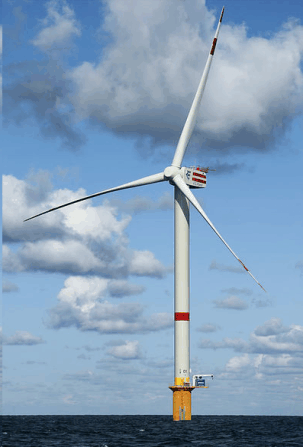
5MW offshore wind generator bottom anchored, North Sea
In 2012, the US added 13 gigawatts (GW) of wind power capacity, bringing the total US wind capacity to 60 GW. The country’s cumulative installed wind energy capacity has increased more than 22-fold since 2000, a trend that can be expected to extended for the next several years. .
Offshore resources are likely to be increasingly developed, because of the higher and more consistent wind velocities to be found in relatively shallow continental shelf areas.
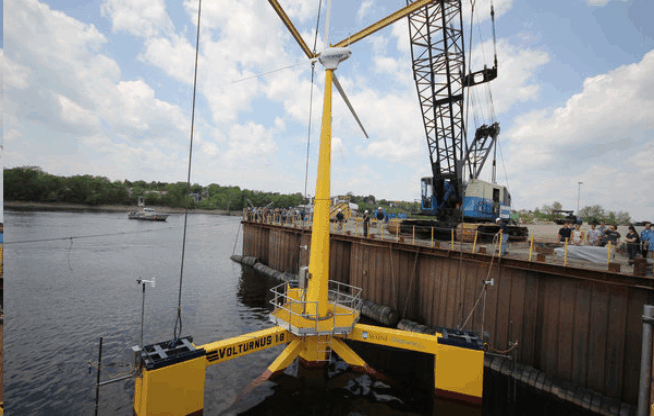
{13}
“Floating” style Wind platform, Maine
New types of “floating tower” windmills, whose stability derives from the center of floatation being many meters beneath the turbulent surface, are being deployed.
These generators, whose capacity will each be between approximately 2 and 5 MW, will be “propeller forward” generators, to avoid both the inefficiency and vibration of being in the “wind shadow” of the support tower.
Each installed generator should be provided with an on-board pumping mechanism to raise and spray ocean water through a discharge port similar to the one described in attachment [1] for terrestrial spraying. The parasitic power would be approximately 50 horsepower, to spray between 1 and 2 cu. ft./sec. ~150" above the ocean surface.
Many near-offshore islands could be used for siting wind-powered spray generators for the same purpose, although the type of rotor would have to be selected for protection of the many birds which usually are found in such locales.
Unlike the apparent rarity of geological circumstances which allow consideration of the sequestration proposal, “offshore winds blowing onshore” is a worldwide phenomenon, and the floating spray plants could be sited almost everywhere around continents.
Per
ClimateWire: Tuesday, August 6, 2013:
The U.S. offshore potential (has) estimated offshore wind resources of around 4,150 GW,....
If, as described, a minor portion of this energy resource was used to simply spray water, and if this was a common world-wide practice, then the ultimate end point would be to bring a significant amount of control over the Earth’s hydrologic cycle. The enhanced water vapor, clouds, and over-land precipitation would resolve in great part the diminution of fresh water realized over the past decades, arising from over-pumping of aquifers, and contamination of other sources.
The future managed burning of carbonaceous fuels could be offset by sequestration and cloud-cover control, within about 150 years, and a stable climate could be realized for an indefinite amount of time.
Oxygen depletion that is killing sea life off Oregon and Washington is probably caused by evolving wind conditions from climate change, rather than pollution, one oceanographer warns.
Kim Murphy
Los Angeles Times
10/09/2009
The “dead zones” may be ameliorated in the act of addressing climate change through sequestration; and also through oxygenating the surface water through the spraying of water offshore to increase cloud cover.
The mixing of oxygen enriched surface waters may be effected by having the pumped water be picked up near the bottom of the water column.
This is highly speculative, but since it arises as a potential “side benefit” to the proposed future offshore spraying, (and is therefore “free”) it is worth mentioning.
Apologetics, and Conclusion
The principal thrust of this paper has been towards CO2 sequestration. The methodology is not “speculative”, but the “effectiveness” is yet to be quantified.
(See attachment 4)
The “downwind precipitation” assertion is not speculative either: it will occur. But the actual difference it will make in rain or snow “on the ground”, or as albedo-enhancing clouds “in the air” will best be decided by seeing what happens, when and if the proposed construct for CO2 direct-air-capture is implemented. (Computer modeling of multi variate chaotic systems is a difficult proposition, and prone to “black swan” effects. )
It occurs to me, and may be apparent to many, that I know very little, about a lot of things: it could be that my greatest skill is in assembling plausible constructs predicated on insufficient knowledge.
And, yet, there remain the facts that this universe is based on quantum theories, string hypotheses, and “attractors” precipitating organized behavior out of chaotic conditions.
Further supporting the somewhat audacious scope of this “paper”, it is my “belief” that the “anthropic principle” dictates the unfoldment of the universe.
Therefore then to say that “stranger things have happened” (than the thrust of this paper being “correct” ) is accurate. .
And cause for hope.
We (humanity) have been “geo engineering” this planet, ignorantly, for millennia.
For this reason, the geological name for the age we live in is the “Anthropocene”.
We are beginning to discern that we must cooperate with one another, and the planet Earth, if we are to thrive.
“Can we and all nations not live in peace?
In our obsession with antagonisms of the moment,
we often forget how much unites all the members of humanity.
Perhaps we need some outside, universal threat
to make us recognize this common bond.
I occasionally think how quickly our differences worldwide would vanish
if we were facing an alien threat from outside this world.”
President Ronald Reagan, United Nations General Assembly, 21 September 1987

{14}
In my limited reading of the teachings of avatars who were at the center of religious traditions, I have seen that many of their “rules to live by” appear to be suggestions as to “how to act” towards each other. Now, it appears that the suggestions are, or soon will become, necessary for survival.
“Old habits”, they say, “die hard.”
This is a true and startling statement, worthy of contemplation, as it has a new meaning .
.
In the introduction of this paper, there was a comment about the current situation having arisen from the aggregate of decisions having been made under the illusion of separation.
They were easy errors to commit:
they appeared to be “rewarding” to those that had their desires consummated, and the “losers” didn’t much count.
Now we find that “we are all in this together”.
“Winners” and “losers”:
the discriminant is increasingly moot.
Truly, we do live in “interesting times.”
Revision control:
II: change in sequestered amount per nozzle adjusted for atmospheric pressure at 4,000 feet, and calculating air mass first, an multiplying by 400 PPM.
III corrected energy used in Edmonston pumping plant
IV. Revised conclusion, deleted ships, calculated energy for offshore,
V expanded RFQ to include playa tests. Rearranged “organization of document” section Minor modifications to text. Saved as RTF
VI Corrected some mis-spellings, added charges, per D O.